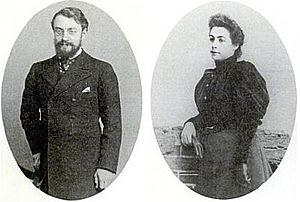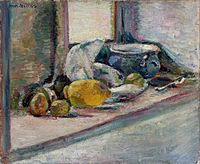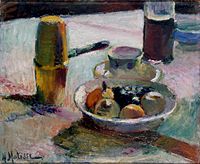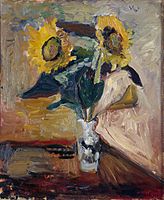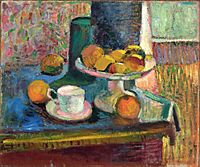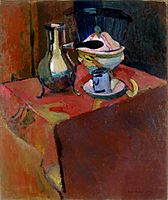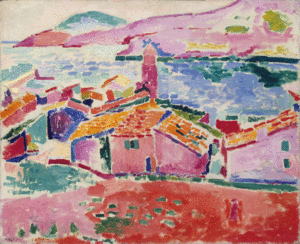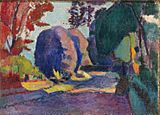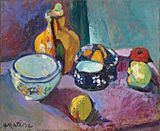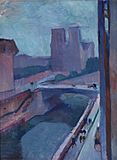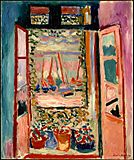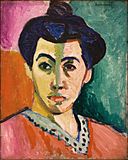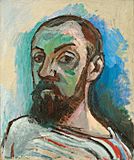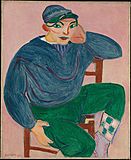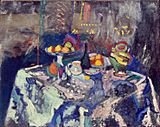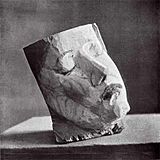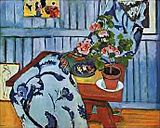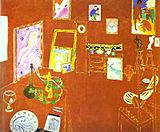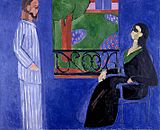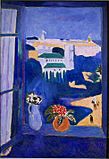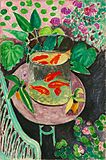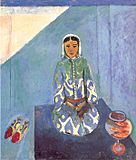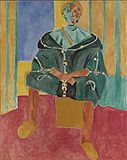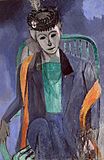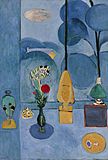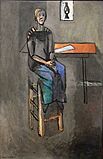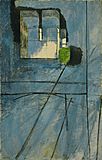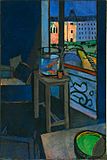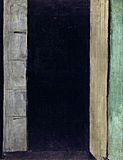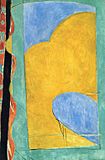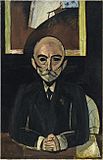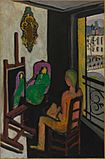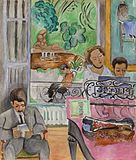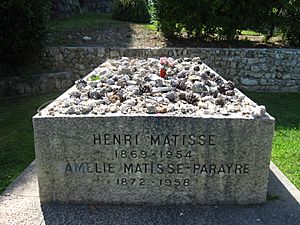Henri Matisse facts for kids
Quick facts for kids
Henri Matisse
|
|
|---|---|
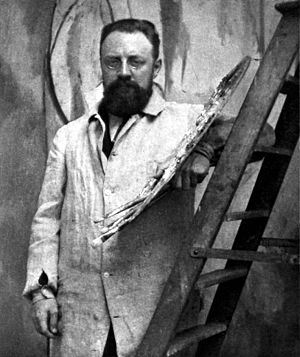
Matisse in 1913
|
|
| Born |
Henri Émile Benoît Matisse
31 December 1869 Le Cateau-Cambrésis, France
|
| Died | 3 November 1954 (aged 84) Nice, France
|
| Education | Académie Julian, William-Adolphe Bouguereau, Gustave Moreau |
| Known for |
|
|
Notable work
|
Woman with a Hat (1905) The Joy of Life (1906) Nu bleu (1907) La Danse (1909) L'Atelier Rouge (1911) |
| Movement | Fauvism, Modernism, Post-Impressionism |
| Spouse(s) |
Amélie Noellie Parayre
(m. 1898; div. 1939) |
| Patron(s) | Sergei Shchukin, Gertrude Stein, Etta Cone, Claribel Cone, Sarah Stein, Albert C. Barnes |
Henri Émile Benoît Matisse ( 31 December 1869 – 3 November 1954) was a French visual artist. He was a draughtsman, printmaker, and sculptor, but is known primarily as a painter. He is recognized as one of leading figures in modern art.
Contents
- Early life
- Love of art
- Change of style
- Fauvism
- Selected works: Paris, 1901–1910
- Sculpture
- Friendship with Picasso
- World War II years
- Personal life and family
- Death
- Interesting facts about Henri Matisse
- Henri Matisse quotes
- Recent exhibitions
- Partial list of works
- Illustrations
- Writings
- Portrayal in media and literature
- See also
Early life
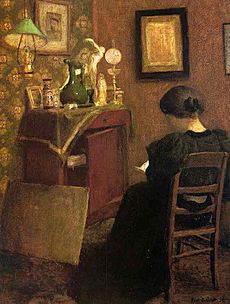
Matisse was born in Le Cateau-Cambrésis, in the Nord department in Northern France on New Year's Eve in 1869. He was the oldest son of a wealthy grain merchant. He grew up in Bohain-en-Vermandois, Picardie, France.
In 1887, he went to Paris to study law. He worked as a court administrator in Le Cateau-Cambrésis after gaining his qualification.
Love of art
He first started to paint at the age of 20, in 1889, when he was recovering from appendicitis. To cheer him up, his is mother brought him art supplies. He discovered "a kind of paradise" as he later described it, and decided to become an artist. This decision deeply disappointed his father.
In 1891, he returned to Paris to study art at the Académie Julian under William-Adolphe Bouguereau and at the Ecole Nationale des Beaux-Arts under Gustave Moreau.
Initially he painted still lifes and landscapes in a traditional style.
Change of style
In 1896, Matisse, an unknown art student at the time, visited the Australian painter John Russell on the island Belle Île off the coast of Brittany. Russell introduced him to Impressionism and to the work of Vincent van Gogh—who had been a friend of Russell—and gave him a Van Gogh drawing.
Matisse's style changed completely. He abandoned his earth-coloured palette for bright colours. He later said Russell was his teacher, and that Russell had explained colour theory to him.
The same year, Matisse exhibited five paintings in the salon of the Société Nationale des Beaux-Arts, two of which were purchased by the state.
Early paintings
-
Blue Pot and Lemon (1897), Hermitage Museum, St. Petersburg, Russia
-
Fruit and Coffeepot (1898), Hermitage Museum, St. Petersburg, Russia
-
Vase of Sunflowers (1898), Hermitage Museum, St. Petersburg, Russia
-
Still Life with Compote, Apples and Oranges, 1899, The Cone Collection, Baltimore Museum of Art
-
Crockery on a Table (1900), Hermitage Museum, St. Petersburg, Russia
Fauvism

Fauvism as a style began around 1900 and continued beyond 1910. The movement as such lasted only a few years, 1904–1908, and had three exhibitions. The leaders of the movement were Matisse and André Derain. The two were friendly rivals, each with his own followers.
Other members were Georges Braque, Raoul Dufy, and Maurice de Vlaminck. The Symbolist painter Gustave Moreau (1826–1898) was the movement's inspirational teacher. As a professor at the École des Beaux-Arts in Paris, he pushed his students to think outside of the lines of formality and to follow their visions.
Matisse and a group of artists now known as "Fauves" exhibited together in a room at the Salon d'Automne in 1905. Matisse showed Open Window and Woman with the Hat at the Salon. The exhibition garnered harsh criticism—"A pot of paint has been flung in the face of the public", said the critic Camille Mauclair—but also some favourable attention. Despite this, Matisse's Woman with a Hatwas bought by Gertrude and Leo Stein.
After 1906, the Fauvist movement declined. This did not affect the career of Matisse. He continued to absorb new influences.
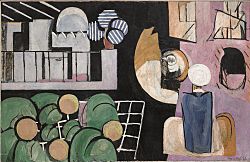
He travelled to Algeria in 1906 to study African art and Primitivism. He spent two months in Spain studying Moorish art and also visited Morocco.
Selected works: Paris, 1901–1910
-
Luxembourg Gardens, 1901, Hermitage Museum, St. Petersburg, Russia
-
Dishes and Fruit, 1901, Hermitage Museum, St. Petersburg, Russia
-
A Glimpse of Notre-Dame in the Late Afternoon, 1902, Albright–Knox Art Gallery, Buffalo, New York
-
Open Window, Collioure, 1905, National Gallery of Art, Washington, D.C.
-
Portrait of Madame Matisse (The green line), 1905, Statens Museum for Kunst, Copenhagen, Denmark
-
Self-Portrait in a Striped T-shirt, 1906, Statens Museum for Kunst, Copenhagen, Denmark
-
The Young Sailor II, 1906, Metropolitan Museum of Art, New York City
-
Vase, Bottle and Fruit, 1906, Hermitage Museum, St. Petersburg, Russia
-
Madras Rouge, The Red Turban, 1907, Barnes Foundation, Philadelphia, Pennsylvania
(Exhibited at the 1913 Armory Show)
Sculpture
Friendship with Picasso
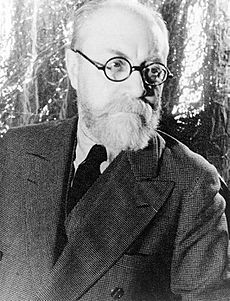
Around April 1906, Matisse met Pablo Picasso, who was 11 years his junior. The two became lifelong friends as well as rivals and are often compared. One key difference between them is that Matisse drew and painted from nature, while Picasso worked from imagination.
The subjects painted most frequently by both artists were women and still lifes.
Selected works: Paris, 1910–1917
-
L'Atelier Rouge, 1911, The Museum of Modern Art, New York City
-
The Conversation, c.1911, The Hermitage, St. Petersburg, Russia
-
Portrait of the Artist's Wife, 1913, Hermitage Museum, Saint Petersburg
-
La glace sans tain (The Blue Window), 1913, Museum of Modern Art
-
Woman on a High Stool, 1914, Museum of Modern Art, New York City
-
View of Notre-Dame, 1914, Museum of Modern Art
-
Les poissons rouges (Interior with a Goldfish Bowl), Musée National d'Art Moderne, Centre Georges Pompidou, Paris
-
The Yellow Curtain, 1915, Museum of Modern Art, New York
World War II years
Matisse was visiting Paris when the Nazis invaded France in June 1940, but managed to make his way back to Nice. His son, Pierre, by then a gallery owner in New York, begged him to flee while he could. Matisse was about to depart for Brazil to escape the occupation of France but changed his mind and remained in Nice, in Vichy France.
Matisse was allowed to exhibit along with other former Fauves and Cubists. He also worked as a graphic artist and produced black-and-white illustrations for several books and over one hundred original lithographs at the Mourlot Studios in Paris.
Matisse remained for the most part isolated in southern France throughout the war.
Collages
In 1941, Matisse was diagnosed with duodenal cancer. The surgery resulted in serious complications from which he nearly died. Painting and sculpture had become physical challenges, so he turned to a new type of medium. With the help of his assistants, he began creating cut paper collages, or decoupage. He would cut sheets of paper, pre-painted with gouache by his assistants, into shapes of varying colours and sizes, and arrange them to form lively compositions.
Initially, these pieces were modest in size, but eventually transformed into murals or room-sized works.
He called the last fourteen years of his life “une seconde vie,” meaning his second life. When talking about his work, Matisse mentioned that, while his mobility was limited, he could wander through gardens in the form of his artwork.
He moved to the hilltop of Vence, France in 1943, where he produced his first major cut-out project for his artist's book titled Jazz.
In 1946, he created mural-size works, such as Oceania the Sky and Oceania the Sea. Under Matisse's direction, Lydia Delectorskaya, his studio assistant, loosely pinned the silhouettes of birds, fish, and marine vegetation directly onto the walls of the room.
In May 1954, his cut out The Sheaf was exhibited at the Salon de Mai and met with success. The artwork was a commission for American collectors Mr and Mrs Brody and the cut out was then adapted to a ceramic for their house in Los Angeles. It is now located in the Los Angeles County Museum of Art.
Chapel
In 1941, a nursing student named Monique Bourgeois responded to an advertisement placed by Matisse for a nurse. A friendship developed between Matisse and Bourgeois. He discovered that she was an amateur artist and taught her about perspective. After Bourgeois left the position to join a convent in 1944, Matisse sometimes contacted her to request that she model for him. Bourgeois became a Dominican nun in 1946, and Matisse painted a chapel in Vence, a small town he moved to in 1943, in her honor.
Personal life and family
With the model Caroline Joblau, he had a daughter, Marguerite, born in 1894.
In 1898, he married Amélie Noellie Parayre; the two raised Marguerite together and had two sons, Jean (born 1899) and Pierre (born 1900). Marguerite and Amélie often served as models for Matisse.
Matisse's wife Amélie ended their 41-year marriage in July 1939, dividing their possessions equally between them.
Matisse's daughter Marguerite died in 1982 while compiling a catalogue of her father's work.
Matisse's son Pierre Matisse (1900–1989) opened a modern art gallery in New York City during the 1930s. The Pierre Matisse Gallery, which was active from 1931 until 1989, represented and exhibited many European artists and a few Americans and Canadians in New York often for the first time.
Henri Matisse's grandson Paul Matisse is an artist and inventor living in Massachusetts. Matisse's great-granddaughter Sophie Matisse is active as an artist. Les Heritiers Matisse functions as his official Estate.
Death
Matisse died of a heart attack at the age of 84 on 3 November 1954. He is buried in the cemetery of the Monastère Notre Dame de Cimiez, in the Cimiez neighbourhood of Nice.
Interesting facts about Henri Matisse
- Matisse was influenced by the works of earlier masters such as Jean-Baptiste-Siméon Chardin, Nicolas Poussin, and Antoine Watteau, as well as by modern artists, such as Édouard Manet, and by Japanese art.
- Chardin was one of the painters Matisse most admired; as an art student he made copies of four of Chardin's paintings in the Louvre.
- Matisse admired other painters and spent a lot of money on their works. A plaster bust by Rodin, a painting by Gauguin, a drawing by Van Gogh, and Cézanne's Three Bathers were on display at his home.
- Matisse had a long friendship with the Russian art collector Sergei Shchukin. He created one of his major works La Danse specially for Shchukin.
- Gertrude Stein and the Cone sisters Claribel and Etta from Baltimore, became major patrons of Matisse and Picasso. They collected hundreds of their paintings and drawings.
- Matisse's friends organized and financed the Académie Matisse in Paris, a private and non-commercial school in which Matisse instructed young artists. It operated from 1907 until 1911.
- His family was involved with the French resistance. His son Pierre, the art dealer in New York, helped the Jewish and anti-Nazi French artists to escape occupied France and enter the United States. Matisse's estranged wife, Amélie, was a typist for the French Underground and jailed for six months. His daughter Marguerite was sentenced to the Ravensbrück concentration camp in Germany by the Gestapo.
- Numerous artworks by Matisse were seized by the Nazis or looted from Jewish collectors or changed hands in forced sales during the Nazi years. The German Lost Art Foundation lists 38 artworks by Matisse in the Lost Art Internet Database.
- In 1952, he established a museum dedicated to his work, the Matisse Museum in Le Cateau, and this museum is now the third-largest collection of Matisse works in France.
- The first painting of Matisse acquired by a public collection was Still Life with Geraniums (1910), exhibited in the Pinakothek der Moderne.
- His The Plum Blossoms (1948) was purchased on 8 September 2005 for the Museum of Modern Art by Henry Kravis and the new president of the museum, Marie-Josée Drouin. Estimated price was US$25 million.
- In 2002, a Matisse sculpture, Reclining Nude I (Dawn), sold for US$9.2 million, a record for a sculpture by the artist.
- The Musée Matisse in Nice, a municipal museum, has one of the world's largest collections of Matisse's works. The museum, which opened in 1963, is located in the Villa des Arènes, a seventeenth-century villa in the neighbourhood of Cimiez.
Henri Matisse quotes
- "There are always flowers for those who want to see them."
- "Derive happiness in oneself from a good day's work, from illuminating the fog that surrounds us."
- "Creativity takes courage."
- "I have always tried to hide my efforts and wished my works to have a light joyousness of springtime which never lets anyone suspect the labors it has cost me."
- "Work cures everything."
Recent exhibitions
Henri Matisse: The Cut-Outs was exhibited at London's Tate Modern, from April to September 2014. The show was the largest and most extensive of the cut-outs ever mounted, including approximately 100 paper maquettes—borrowed from international public and private collections—as well as a selection of related drawings, prints, illustrated books, stained glass, and textiles. In total, the retrospective featured 130 works encompassing his practice from 1937 to 1954. The Tate Modern show was the first in its history to attract more than half a million people.
The show then traveled to New York's Museum of Modern Art, where it was on display through 10 February 2015. The newly conserved cut-out, The Swimming Pool, which had been off view for more than 20 years prior, returned to the galleries as the centerpiece of the exhibition.
Partial list of works
- Woman Reading (1894), Musée National d'Art Moderne Paris
- Le Mur Rose (1898), Musée National d'Art Moderne
- Canal du Midi (1898), Thyssen-Bornemisza Museum
- Notre-Dame, une fin d'après-midi (1902), Albright-Knox Art Gallery, Buffalo, New York
- Luxe, Calme, et Volupté (1904), Musée National d'Art Moderne
- Green Stripe (1905)
- The Open Window (1905)
- Woman with a Hat (1905)
- Les toits de Collioure (1905)
- Landscape at Collioure (1905)
- Le bonheur de vivre (1906)
- The Young Sailor II (1906)
- Self-Portrait in a Striped T-shirt (1906)
- Madras Rouge (1907)
- The Dessert: Harmony in Red (The Red Room) (1908)
- Bathers with a Turtle (1908), Saint Louis Art Museum, Missouri
- La Danse (1909)
- Still Life with Geraniums (1910)
- L'Atelier Rouge (1911)
- The Conversation (1908–1912)
- Zorah on the Terrace (1912)
- Goldfish (1912)
- Le Rifain assis (1912)
- Window at Tangier (1912)
- Le rideau jaune (the yellow curtain) (1915)
- The Window (1916), Detroit Institute of Arts, Michigan
- The Painter and His Model (1916–17)
- The Windshield, On the Road to Villacoublay (1917), Cleveland Museum of Art
- La leçon de musique (1917)
- Interior A Nice (1920)
- Festival of Flowers, Nice (1923), Cleveland Museum of Art
- Odalisque with Raised Arms (1923), National Gallery of Art, Washington, D.C.
- Yellow Odalisque (1926)
- The Dance II (1932), triptych mural (45 ft by 15 ft) in the Barnes Foundation of Philadelphia
- Robe violette et Anémones (1937)
- Woman in a Purple Coat (1937)
- Le Rêve de 1940 (the dream of 1940) (1940)
- La Blouse Roumaine (1940)
- Interior with an Etruscan Vase (1940), Cleveland Museum of Art
- Le Lanceur De Couteaux (1943)
- Annelies, White Tulips and Anemones (1944), Honolulu Museum of Art
- L'Asie (1946)
- Deux fillettes, fond jaune et rouge (1947)
- Jazz (1947)
- The Plum Blossoms (1948)
- Chapelle du Saint-Marie du Rosaire (1948–1951)
- Beasts of the Sea (1950)
- Facial-maschera (1951)
- The Sorrows of the King (1952)
- Black Leaf on Green Background (1952)
- La Négresse (1952)
- The Snail (1953)
- Le Bateau (1954) This gouache created a minor stir when the MoMA mistakenly displayed it upside-down for 47 days in 1961.
Illustrations
- Jean Cocteau, Bertrand Guégan (1892–1943); L'almanach de Cocagne pour l'an 1920–1922, Dédié aux vrais Gourmands Et aux Francs Buveurs
Writings
- Notes of a Painter ("Note d'un peintre"), 1908
- Painter's Notes on Drawing ("Notes d'un peintre sur son dessin"), July 1939
- Jazz, 1947
- Matisse on Art, collected by Jack D. Flam, 1973, ISBN: 0-7148-1518-7
- Chatting with Henri Matisse: The Lost 1941 Interview, Getty Publications, 2013, ISBN: 978-1-60606-128-2
Portrayal in media and literature
Film dramatisations
- A film called Masterpiece, about the artist and his relationship with Monique Bourgeois, was proposed in 2011. Deepa Mehta intended to direct with Al Pacino to play Henri Matisse.
- Matisse was played by Yves-Antoine Spoto in the 2011 film Midnight in Paris.
- Matisse was portrayed by Joss Ackland in the 1996 Merchant Ivory production of Surviving Picasso.
Exhibition on screen
- The Museum of Modern Art's Matisse retrospective was part of the film series "Exhibition on Screen", which broadcasts productions to movie theaters.
- The film Matisse From MoMA and Tate Modern combines high-definition footage of the galleries with commentary from curators, museum administrators and, through narration of words from the past, Matisse himself. "We want to show the exhibition as well as we possibly can to the audience who can’t get there", said director Phil Grabsky. Inspired by a similar "event cinema" produced by the Met, Grabsky started his series to simulate the experience of strolling through an art exhibit.
Literature
- The Ray Bradbury short story "The Watchful Poker Chip of H. Matisse" contains an allusion to the artist painting an eye on a poker chip for an American man to use as a monocle.
- In Michael Ondaatje's Running in the Family, there is a section called 'Don't talk to me about Matisse'
- In Henry Miller's Tropic of Cancer there are multiple pages lionizing the works and importance of "the bright sage" Matisse, his hero.
Music
- The British composer Peter Seabourne wrote a septet "The Sadness of the King" (2007) inspired by the late paper cut La Tristesse du Roi.
See also
 In Spanish: Henri Matisse para niños
In Spanish: Henri Matisse para niños


